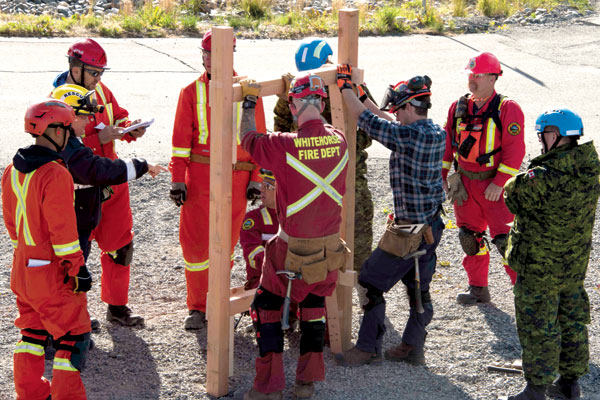Earthquake scenario part of Operation Nanook
By Lookout on Sep 14, 2016 with Comments 0

CFB Esquimalt and CFB Comox Urban Search and Rescue teams conduct training with the Whitehorse Fire Department, Watson Lake Fire Department and Yukon Government Community Services. Photo by MCpl HJL MacRae, 4 Wing Imaging
Peter Mallett, Staff Writer ~
As last month’s deadly earthquake in Italy unfolded, participants in Operation Nanook in Canada’s far north were once again reminded why their earthquake preparedness drill was so important.
While the recovery operation was unfolding in Southern Europe following the magnitude 6.2 earthquake that flattened three medieval towns in central Italy in the early morning hours of Aug. 24, 8,200 kilometres away in Whitehorse, Glenn Cooper, CFB Esquimalt’s Urban Search and Rescue Team Lead, was in the midst of training Yukon government officials about what to do in their community if an earthquake stuck.
“The real earthquake happened on day three of our training and one of the first things we did as instructors was put up video clips during our instruction to show the importance of being properly prepared,” said Cooper. “It was significant for us both in terms of having properly trained rescuers, but also for the average citizen of being informed and having a properly stocked family emergency kit.”
This is the first time Op Nanook focused on a seismic event, with the entire exercise involving 850 federal, territorial and municipal government employees and officials. Cooper’s team of seven personnel from Esquimalt were tasked with responding to a simulated earthquake situation in Haines Junction, Yukon, located 130 kilometres west of Whitehorse.
Here on base, Cooper’s Urban Search and Rescue (USAR) unit, part of Real Property Operations, are not first responders during an earthquake, but rather experts on the safe rescue of victims trapped inside buildings that have collapsed.
USAR draws their expertise from members across the Formation, “from supply techs to electricians” according to Cooper, and much like a volunteer fire department “spring into action when they are needed.”
Cooper’s team was also involved in training members of the Yukon government, emergency services and Canada’s military on the Rapid Damage Assessment, which determines whether a structure is safe to enter after an earthquake or other catastrophic event.
Esquimalt’s Fleet Diving Unit (FDU) also had a team of 10 personnel involved in Op Nanook, which ended Sept. 8.
Working out of Whitehorse, FDU personnel had two responsibilities in the exercise: an infrastructure survey of the Robert Campbell Bridge that spans the Yukon River, connecting the community of Riverdale with downtown Whitehorse, and a water search and rescue operation involving a fictitious missing airplane, and body recovery along with the recovery of the plane’s black box.
“Everything went well for our unit during the operation,” said FDU Operations Officer Lt(N) Kevin Darling. “The biggest problems for our team were overcoming the fast-moving water [in the Yukon River] and the normal logistical strains of such an enormous operation.”
Lt(N) Darling noted in order for the dive team to deploy, his group worked closely with local officials to reduce the dangerous currents in the Yukon River by lessening the water flow at a dam located upstream.
He and Cooper both noted the importance of all units, branches of government and individuals participating in Nanook working in coordinated effort. Both said they were encouraged by the success of the mission and the valuable training and knowledge it provided participants.
“Everyone was collaborating and sharing their knowledge and I think we achieved the main purpose of all levels of government and branches of the military working together in major disaster,” said Cooper. “I was amazed at how seamlessly we were able to accomplish our objectives and it went 100 percent better than I thought.”
Cooper reminds all civilian and military personnel on base to become better prepared and educated about earthquakes, while noting some life-saving tips are located on the Government of Canada webpage: www.getprepared.gc.ca/cnt/hzd/rthqks-eng.aspx
Filed Under: Top Stories
About the Author:





